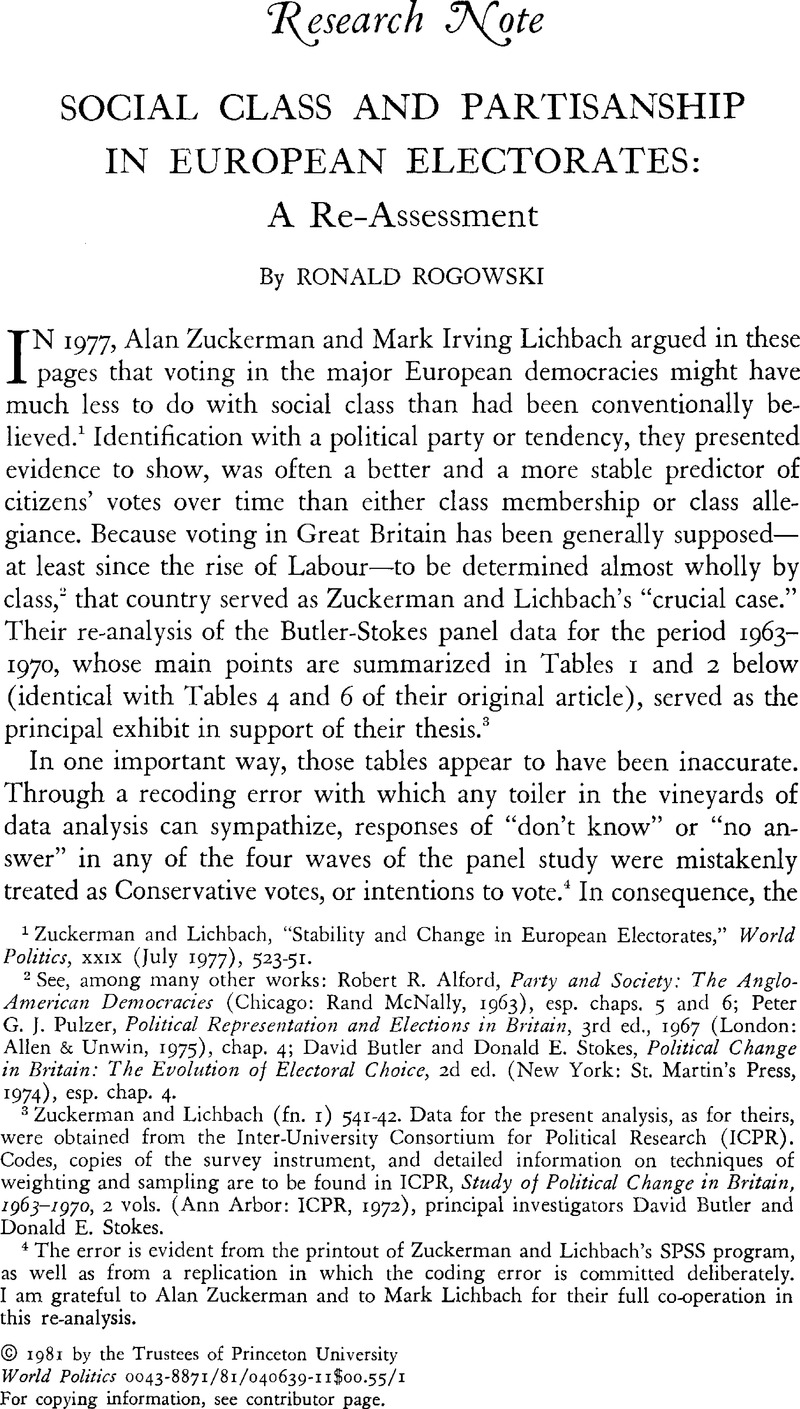Published online by Cambridge University Press: 13 June 2011

1 Zuckerman, and Lichbach, , “Stability and Change in European Electorates,” World Politics, XXIX (July 1977), 523–51CrossRefGoogle Scholar.
2 See, among many other works: Alford, Robert R., Party and Society: The Anglo- American Democracies (Chicago: Rand McNally, 1963), esp. chaps. 5 and 6Google Scholar; Pulzer, Peter G. J., Political Representation and Elections in Britain, 3rd ed., 1967 (London: Allen & Unwin, 1975), chap. 4Google Scholar; Butler, David and Stokes, Donald E., Political Change in Britain: The Evolution of Electoral Choice, 2d ed. (New York: St. Martin's Press, 1974), esp. chap. 4CrossRefGoogle Scholar.
3 Zuckerman and Lichbach (fn. 1) 541–42. Data for the present analysis, as for theirs, were obtained from the Inter-University Consortium for Political Research (ICPR). Codes, copies of the survey instrument, and detailed information on techniques of weighting and sampling are to be found in ICPR, Study of Political Change in Britain, 1963–1970, 2 vols. (Ann Arbor: ICPR, 1972)Google Scholar, principal investigators David Butler and Donald E. Stokes.
4 The error is evident from the printout of Zuckerman and Lichbach's SPSS program, as well as from a replication in which the coding error is committed deliberately. I am grateful to Alan Zuckerman and to Mark Lichbach for their full co-operation in this re-analysis.
5 Those whose recollections were uncertain—don't know, or no response—were, however, included.
6 The classical discussion is in Weber, Max, Wirtschaft und Gesellschaft: Gundriss der verstehenden Soziologie, 1st ed., 1922 (Cologne and Berlin: Kiepenheuer & Witsch, 1964), section 1, chap. 4, 223–29Google Scholar. One of the most discerning treatments of class in Britain is Goldthorpe, John H. and others, The Affluent Worker, II, Political Attitudes and Behaviour (Cambridge: Cambridge University Press, 1968), chaps. 3 and 4Google Scholar.
7 Besides Goldthorpe, see Butler and Stokes (fn. 1), chap. 5, and Runciman, W. G., Relative Deprivation and Social Justice: A Study of Attitudes to Social Inequality in Twentieth-Century England (Berkeley and Los Angeles: University of California Press, 1966), esp. chaps. 10 and 11Google Scholar. A promising recent effort to construct a multivariate measure based on more solid theoretical premises is Dunleavy, Patrick, “The Urban Basis of Political Alignment: Social Class, Domestic Property Ownership, and State Intervention in Consumption Processes,” British Journal of Political Science, IX (October 1979), 409–43CrossRefGoogle Scholar.
8 The size of the sample precluded extensive crosstabulation, but two- and three-way crosstabs were used preliminarily to suggest appropriate ways of “dummying” the variables. Other variables that were canvassed, but that turned out to have only weak effects independent of those presented here, included occupational grade of the respondent, estimated proportion of trade-unionists among co-workers, and type of housing occupied. All regressions reported here were performed on unweighted samples. Replication with weighted samples produced slightly stronger estimates of association, of course.
9 Inserting a measure of class allegiance, or “subjective” class identification, after all of the measures of “objective” class membership, raises the R 2 to .31; bringing in the measures of partisan self-identification after that still increases the R 2 to .75, an increment of .44.
10 Every attempt to collapse categories so as to eliminate variables that performed weakly (i.e., whose estimated coefficient was less than twice the standard error of the estimate) merely raised the t-scores of the variables of partisanship and dropped those of the measures of class. The R 2, predictably, remained about the same (.74 in most tests).
11 See, for example, Nie, Norman H., Verba, Sidney, and Petrocik, John R., The Changing American Voter (Cambridge: Harvard University Press, 1976), 303n. and sources there citedGoogle Scholar.
12 Regressing consistency of voting only on the variables associated with class membership— i.e., not controlling for partisanship—produces a maximum pro-Conservative score of 1.45 and a maximum pro-Labour score of 5.73, for a difference of 4.28, with the already reported R 2 of .28. Regressing the dependent variable only on the variables of partisanship yields an estimate of 1.57 for those who called themselves strongly Conservative in 1963, and an estimate of 6.47 for those who called themselves strongly pro-Labour: a difference of 4.90, with an R 2 (as mentioned) of .74.
13 See, in particular, Dahrendorf, Ralf, Gesellschaft und Demokratie in Deutschland (Munich: R. Piper & Co., 1968), chap. 8. But cf. Lewis }. Edinger, Politics in West Germany, id. ed. (Boston: Little, Brown, 1977), 181–82Google Scholar; also Klaus Liepelt and Mitscherlich, Walter, Thesen zur Wahlerjluhj.uation (Frankfurt/Main: Europaische Verlagsanstalt, 1968), 71–77Google Scholar.
14 Describing variables are all dummies. Here, it has been possible to collapse categories to leave only variables whose estimated value is at or near twice the standard error of the estimate.
15 See again Dunleavy (fn. 7), esp. 436–42.
16 Crewe, Ivor, Siirlvik, Bo, and fames Alt, “Partisan Dealignment in Britain, 1962. 1974,” British Journal of Political Science, VII (April 1977), 129–90CrossRefGoogle Scholar, at 164–66; Crewe, Ivor, “Prospects for Party Realignment: An Anglo-American Comparison,” Comparative Politics, XII (July 1980), 379–400, at 387CrossRefGoogle Scholar.
17 Shively, W. Philips, “Party Identification, Party Choice, and Voting Stability: The Weimar Case,” American Political Science Review, Vol. 66 (December 1972), 1203–25CrossRefGoogle Scholar; Pappi, Franz Urban, “Parteiensystem und Sozialstruktur in der Bundesrepublik,” Politische Vierteljahresschrijt, XIV (No. 2, 1973), 191–213, esp. 199.Google Scholar